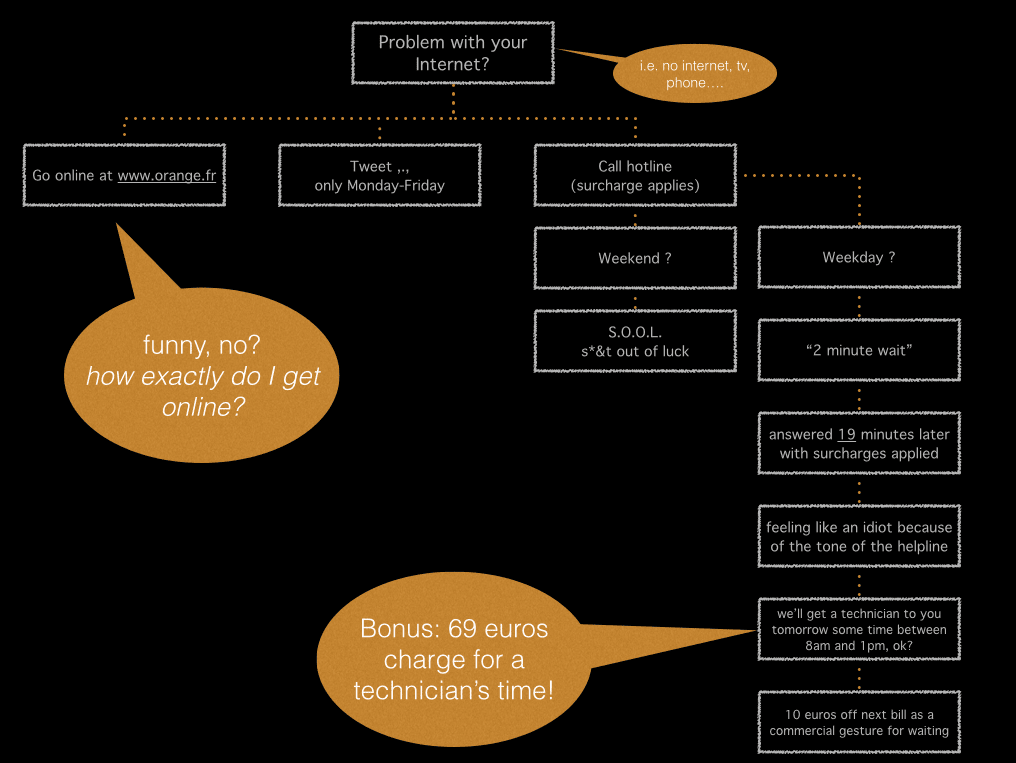If I asked you to think of companies that are proud of their “innovation” reputation, who comes to mind? Probably quite a few companies. Chances are that they boast about their renowned product prowess as well as the excellent career paths they offer to current and prospective employees. However, if I also asked you which of those companies also had an awesome customer experience, I wonder how many companies we might be left with? It seems very difficult — and at times incompatible — to be both innovative in product and excellent in customer service, much less in customer experience. In this omnichannel world, companies need to understand and learn to execute against extremely varied customer journeys.
The road to digital leads to customer centricity
With the mainstream arrival of digital has come the realization in board rooms that (a) the customer has a voice [and choice]; (b) the customer is more digital than brands allow; and (c) the path to purchase and fidelity is more complex. A necessary conclusion and relatively new emphasis in many board rooms has been on customer centricity. As a result, there seems to a great amount of attention on and urgency in creating and enhancing the customer journey. However, taking a theoretical customer journey and turning it into reality is a whole other affair. At the very heart of a superior customer experience is customer service. There are many wrenches that get thrown into the works, such as:
- lack of coordination
- lack of knowledge of the customer (i.e. no single view)
- improper infrastructure
- lack of attention to details
- lack of resources
- lack of a leadership that exemplifies a customer centric mindset
- …
Customer service levels – a proxy for customer centricity
I had a recent “experience” with my telco operator in France that speaks volumes of the challenges that companies have in driving a truly customer-centric customer service. My “customer journey” was an individual one, as they all are by definition; yet, I have to believe mine was not and is not a unique or isolated case. It concerned an unfortunate breakdown in my triple-play service at home (including home office) on a Saturday evening.
The customer situation
Here’s the context and case:
- I have been a business customer (mobile) for 5+ years
- I am also a domestic (home) customer for 3+ years of this telco
- I have triple-play at home (tv, phone and internet with fiber optic)
- Saturday evening, the connection goes down… completely dead.
- Despite numerous reboots and resets, the system remained kaput.
The customer service journey
This customer service journey identifies a number of flaws in the system, all the while exposing the challenging business issues related to managing the omnichannel customer. Once I had ascertained that I was not able to get the service back online, I called the helpline (with surcharges applied). The automated service advised me on two things:
- to go online to get your question answered (without access to internet, this was redundant)
- to wait until Monday when the help desk re-opens (that meant waiting 36+ hours).
Subsequently, I sent out a tweet in the hopes that the SM team might still read the occasional mayday over the weekend. No such luck. Naturally, there would be no open store (on Sunday) that might be able to provide an alternative solution. The following 36 hours we just waited in the void. [The New Opportunity = Learn To Live Disconnected!].
When calling the helpline first thing on Monday morning, I was told automatically that the wait would be two minutes to get someone on the end of the line. I waited for 19 paid minutes. (Don’t you love how the phones these days make the time spent holding easy to know). The diagnostic by the phone agent was that they needed to send a technician to change the box (the following day). And, to my surprise and consternation, the repair of their box would be at my expense (69 euros).
N.B. The Twitter account duly replied to me on Monday morning, without any substantive guidance or help.
Mapping out the journey
Here is a schema that shows the different paths tried during my hellish customer service journey. There were too many dead-ends and even the proposed solution was designed to frustrate. It was painfully obvious that none of the channels was connected with the other.
Denouement & Resolution
In my particular case, the box was indeed replaced and the fees were waived. Further, I have been given access to a specific number to be able to escalate my case in any future issue. That is a valuable result. However, the question for any organization is: how to create an excellent customer service for such a large number of clients in a sensible (effective) manner? Here are five key actions that I believe a brand and its top management should consider:
- Have the entire executive team personally experience customer service as if they were a regular paying customer – no favors allowed. {If you agree, please tweet this!}
- Make customer service a company-wide project (for example, by involving retail, marketing, analytics, operations & IT and research…) {Tweet this!}
- Collate, identify, document and graph the important customer journey paths (in this case, looking specifically at the customer service after-sales) {Tweet this!}
- Evaluate the killer metrics to focus on customer satisfaction {Tweet this!}
- Benchmark your customer service against the likes of Amazon & Zappos as opposed to your industry competitor. {Tweet this!}
Getting customer service right is as much a matter of mindset as it is about processes and infrastructure. In some industries, it is harder than others to achieve total satisfaction or customer happiness. Nonetheless, three things strike me as absolutely fundamental. (1) The CEO must set the example and lead the charge. (2) It is an evolutionary process that requires testing & learning. (3) Delegation and intra-departmental coordination are the killer apps of a great customer service. {Please tweet this!}
Your thoughts and reactions are welcome.















Trackbacks/Pingbacks